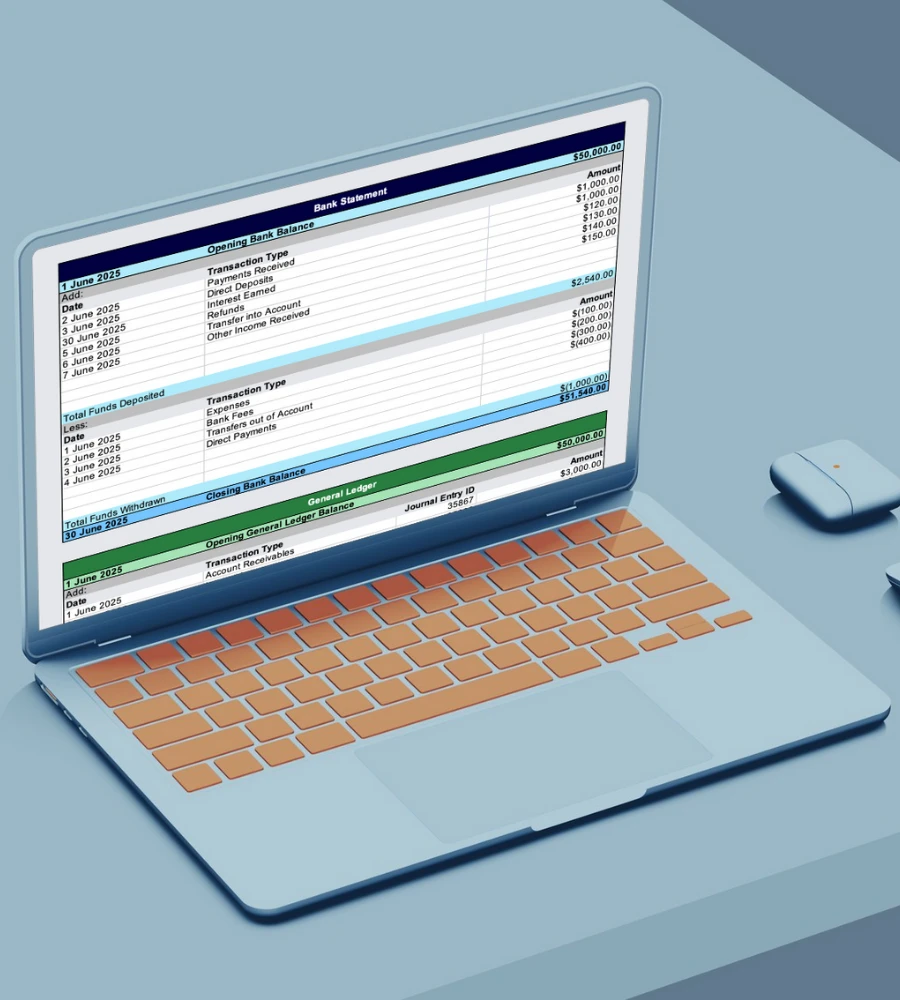Free Bank Reconciliation Template
Simplify Your Bank Reconciliation Process
Reconciling your bank statements doesn’t have to be time-consuming or complicated. Our free Excel-based Bank Reconciliation Template is a spreadsheet that helps you:
- Match bank transactions with your general ledger
- Quickly identify and resolve discrepancies
- Maintain accurate financial records
- Stay organized and audit-ready
This easy-to-use template is designed to streamline your workflow and save time during month-end close.


What’s Inside the Template?
This free, easy-to-use Excel spreadsheet is designed to help you confidently complete your bank reconciliations. It includes:
- Structured sections for bank statements and internal records to help you track and compare transactions with clarity.
- Tables for deposits and withdrawals that align with your general ledger entries and journal IDs.
- Built-in calculations to automatically total your figures and flag discrepancies between your bank and book balances.
- A final reconciliation summary showing any differences and adjustments needed—making it easier to close the period cleanly.
- Customizable fields so you can tailor it to your specific accounts, periods, and workflows.
With this template, you’ll stay organized, reduce errors, and save time every month.
Download your free bank reconciliation template
Frequently Asked Questions
Is this bank reconciliation template free?
Yes! This template is 100% free to download and use. It’s designed to save you time and reduce errors in your reconciliation process.
Can I customize the template for my business?
Absolutely. The template is built in Excel and fully editable. You can modify the categories, time periods, transaction types, and formatting to suit your business needs.
Who should use a bank reconciliation template?
Small business owners, accountants, bookkeepers, and finance teams can all benefit from using a bank reconciliation template. It’s especially helpful for organizations looking to streamline their monthly or quarterly close processes.
How often should I do a bank reconciliation?
Most businesses perform bank reconciliations monthly, but depending on your transaction volume, you may want to reconcile weekly or even daily. Regular reconciliations help you catch errors early and maintain accurate books.
What is a bank reconciliation template?
A bank reconciliation template is a pre-formatted document—usually an Excel spreadsheet—that helps businesses compare their internal financial records with bank statements. It’s used to identify and correct discrepancies, ensuring accurate financial reporting.
What is a bank reconciliation statement?
A bank reconciliation statement is a document that compares a company’s internal financial records with all the bank account transactions recorded over a given period. It helps identify any differences between the two, such as outstanding checks, deposits in transit, or errors, and ensures the accuracy of the company’s cash balance. This process is essential for maintaining reliable financial records and detecting potential issues early.
Why is bank reconciliation important?
Bank reconciliation is important because it ensures the accuracy of your financial records by comparing your internal ledger with your bank statement. Regular reconciliations help detect errors, missing transactions, and timing differences. Most importantly, bank reconciliation helps detect fraud and cash manipulations, giving you greater control and oversight of your financial health. It’s a critical part of maintaining trustworthy, audit-ready books.
